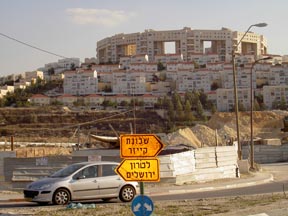Sociologist uses Fulbright to study housing patterns in Israel
|
Sociologist Anne Shlay said that for a long time, despite being an American Jew, she never gave Israel a second thought. “I’d never been to Israel, I hadn’t thought about Israel, and I didn’t have any academic interest in it.” That all changed, however, during a late 2004 trip to the country with her synagogue, when Shlay says she became fascinated. Inspired, she drafted a proposal for a Fulbright Scholarship that would allow her to spend five months in Israel studying housing development patterns. Shlay was awarded the scholarship and traveled to Israel in August of 2006; she returned this January. |
 Photo courtesy Anne Shlay
Sociologist Anne Shlay traveled to Israel on a Fulbright Scholarship to studying high-density housing communities. Modi’in, shown here, is a government-planned city located between Jerusalem and Tel Aviv.
|
|
Shlay, who came to Temple in 1992, is a sociologist with a broad interested in urban sociology and the spatial distribution of inequality, but who has done research with people in a variety of other fields including developmental psychology. Most of her previous research was conducted in a local setting.
“Before I went to Israel,” she said, “my idea of a field trip was going to look at a local public housing development.” Shlay said what most interests her about the housing she traveled to study is the fact that, unlike the United States, where urban centers are surrounded by suburban areas full of low-density housing, Israel is primarily occupied with high-density housing. While in Israel, Shlay was based at Hebrew University in the geography department and the school of public policy. Close by, in a Kibbutz outside of Jerusalem, was her 17-year-old daughter, who had traveled with her and was studying at an American school run by the Jewish reform movement. Shlay’s first step in getting to know the “lay of the land” was immersing herself in literature about housing communities, a task made easier by Hebrew University’s extensive library with a card catalogue in English, Hebrew, Russian and Arabic. “At the outset of the project, I didn’t really know that much, other than the fact that I was fascinated with the housing system,” she said. “I wanted to know how it was designed and planned, and what the future was for these high-density communities.” Next, Shlay traveled to housing communities as often as she could, relying on friends and colleagues to serve as guides. One particularly helpful guide was a graduate student in Hebrew University’s geography department; Shlay plans to co-author an article about her findings with him. Shlay also conducted a series of interviews with those on the supply side of the housing equation — a major area of her research interest — including government officials, entrepreneurs, developers and academics. According to Shlay, although the housing process is primarily free-market, the government is heavily involved in planning, and owns 98 percent of undeveloped land. Shlay said that the reasons for the attachment to high-density housing In Israel are twofold. First, there are issues of physical space. While much of the land in Israel is undeveloped, Shlay said that there is a widespread belief that land must be conserved. “Israel is a tiny country,” says Shlay matter-of-factly, adding that at times immigration has been intense. “In the late 1980s and early ’90s, Israel gained a million Russian immigrants, and the government needed to plan communities to house them.” Second, there are issues of politics. According to Shlay, high-density housing is often constructed near the green line, creating what Israelis call “facts on the ground.” That is, by constructing buildings and filling them with people, the property becomes de facto Israeli. Shlay noted that some of these cities by the green line have more than 30,000 people in them. “If you build something, essentially it becomes yours. I was really concerned about the amount of housing I saw outside of the green line,” said Shlay. “So much of the conflict in that area is about land, and both Arabs and Israelis take part in the practice of creating ‘facts on the ground.’” Although Shlay spent nearly half a year in Israel, she still plans to go back for a month this summer to collect more data. She will present her article on Israel’s high-density housing communities at a conference on international suburbanization patterns next April.
|
|